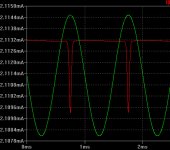Matched BJT current mirror output is still within 1% at < 0.5 V--then you have 5-10 V on the other leg to make a CCS.
That's essentially what I'm doing for the input stage and current mirror CCS--just that the mirror ratios ain't unity but 4. The transistion between current mirror and CCS is actually an unsharp one. In any case the anode of D3 needs to swing ~400 mV bejond the positive rail--no active CCS could provide this unless you somehow sneak in a DC-DC converter.
The C is physically large compared to the 2 BJT options above.
In that particular case the cap needs to be rated for just 6.3 V (or even less), so the size is relatively modest. I'm more concerned that the boostrapping makes the output stage bias current a function of supply voltage and hence battery life. If we accept another 5 mA of quiescent current a zener diode might solve this.
Samuel
Last edited:
What CCS are used in monolithic opamps?
Please check the reference I've given above... The trick of working at low voltages ain't just the CCSs; you also need different input and output stage topologies.
Samuel
It's not really clear to me what the graph shows but if the red line plots the collector/drain current of a CCS which saturates at the positive peak of the output voltage (green line), then yes. Of course what we see here is just the onset of saturation--the 3.6 uA difference (relative to the 2.1 mA nominal current) won't make gross distortion.
Samuel
Samuel
Nice to find this thread. Was just trying to simulate an ad797 in Multisim but had some hard time with the parameters...IMO two-stage amps such as ad797 have a much higher phase margin when compared to other traditional three-staged amps, and facilitates to a more relaxed and natural sound. I'll add level shifting to the "Magic Transistor", use a zener for the Vref and run the amp with +-15V, hope it works out. 🙂
- Status
- Not open for further replies.
- Home
- Amplifiers
- Solid State
- Discrete AD797 up and running
